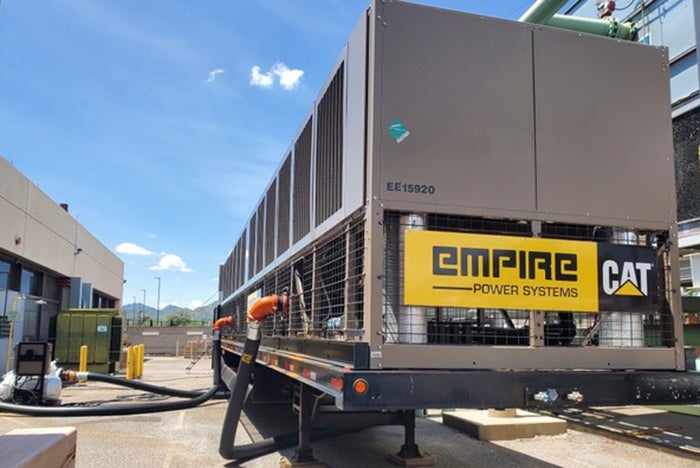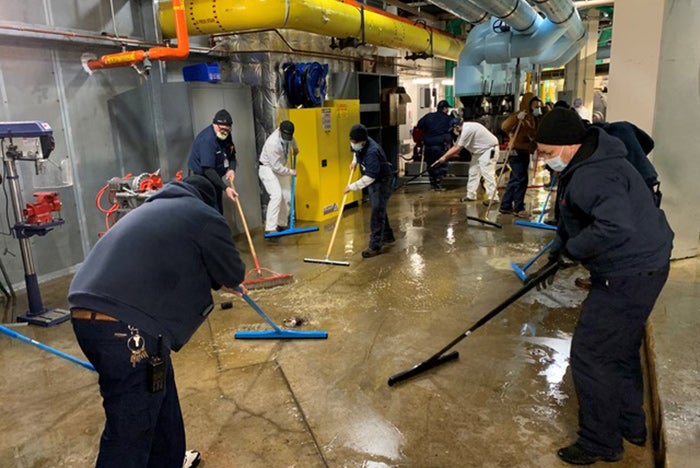How one hospital prepared for the effects of extreme heat

Carondelet Health works with business partners to supply portable equipment that will keep its facilities running during extreme heat events.
Image courtesy of Carondelet Health Network
Editor’s note: This article is the second part of a series on the impacts of climate change and climate events on hospitals and health care facilities and related planning, preparedness and response efforts.
The summer of 2021 saw record-breaking heatwaves across the country. In mid-June, seven Western states — California, Arizona, New Mexico, Utah, Colorado, Wyoming and Montana — recorded all-time high temperatures. A week later, unprecedented heat descended on the Pacific Northwest, a region much less accustomed to and prepared for extreme heat. In Portland, Ore., the average temperature from June 26 to June 29 was 112 degrees Fahrenheit.
During an extreme heat event, a health care facility’s infrastructure can be pushed to its limits. Aging HVAC systems may struggle to meet set point temperatures and keep areas appropriately cool. In addition, technological failures can occur, resulting in a cascade effect that ultimately impacts staff and patients, says Jacob Linhart, CHFM, CHC, market director of facilities operations and construction for Carondelet Health Network, Tucson, Ariz.
“For example, main distribution frames and independent distribution frames, which are IT rooms with server switches, these rooms have to stay cool,” he says. “If they’re not cool, everything in that room is going to go down. If you lose your chiller, fan and induction coils [will] lose cooling capabilities, and then the whole building gets warm. You lose your ability to combat the heat load produced by the building, and folks get uncomfortable. Inherently, the quality of patient care subsides.”
Under extreme temperature conditions, the municipal utility grid can become overtaxed, which can result in rolling brownouts and blackouts. When residential buildings lose power, the population is subjected to extremely dangerous conditions. Individuals can suffer dehydration and heat sickness, including heat exhaustion, heat cramps and heat stroke. Vulnerable populations — such as the elderly, homeless and displaced individuals, individuals with preexisting health conditions and low-income communities — experience particularly severe health effects from extreme heat.
And during these community-wide crises, hospitals contend with the impacts.
“There is a kind of ripple effect that happens upstream from the hospital in terms of the infrastructure and the electrical grid,” Linhart says. “People see a hospital as a safe haven. If the grid does go down and air conditioners fail, they seek refuge from the heat and they flock to areas that have backup systems where they can get cool. It causes throughput issues for hospitals, security issues, staging and access issues, and, in extreme cases, supply chain issues. Extreme heat situations quickly transform into a multifaceted emergency.”
Linhart says establishing relationships in advance is key in preparing for extreme heat events. “In a state like Arizona, a large hospital group consisting of several hospitals can split the cost of having equipment on the ready. Lessons learned from past experience taught me to do exactly that.”
He has also established contract service agreements with the regional utility provider for all the hospitals he oversees. For his facilities, he can electively switch to generator mode to mitigate brownouts until the grid is stabilized. Such an arrangement ultimately benefits the health care system, the community served and the utility provider.
“In doing so, we remove some load from the grid and this helps the provider sustain the electrical network and keep everyone’s air conditioners on,” he notes. “In turn, they pay us a premium and we have a less volatile electrical power grid throughout the entire city. It also prevents the hospital from enduring power shutting off and on and off and on as the normal power feed goes offline and returns.”
In addition, there are memoranda of understanding in place with business partners to ensure that Carondelet Health is first in line when its facilities need rental chillers or generators during a systems failure. Such arrangements are useful as long as established relationships and needs are delineated in advance, Linhart says.
“Just over the last summer, both generators and chillers were mobilized to both of our large hospitals because we experienced catastrophic chiller failure at two of the four hospitals within a two-week timeframe,” he says. “It was extremely humid and extremely hot for three weeks straight.”
Linhart says that arranging to have dedicated equipment available before the summer is crucial. Carondelet Health keeps a supply of emergency preparedness resources on hand, which is especially important because rental equipment can be difficult to impossible to procure during an extreme heat event. Portable air conditioners and portable generators allow for strategic cooling, and tents and modular structures with portable lights provide additional space for triage and discharge when the hospital facility is at staff or physical capacity.
“This past summer was cutthroat because there was not one portable chiller or portable generator available,” Linhart says. “What we realized is that no one had the ability to help anyone else because they were struggling to take care of their own facility first. There was nothing that any hospital could spare to help out another one.”
As health facilities managers plan and prepare for extreme heat, they may also be contending with other extreme climate events that are affected by high temperatures, such as drought and wildfires. A comprehensive hazard vulnerability analysis can help highlight the relationships between these impacts, how to prioritize risk, and how to effectively plan and prepare.
“Heat sickness in Arizona is a real thing,” Linhart says. “Heat was responsible for 2,429 deaths between 2010 and 2020. Preparing for extreme heat can be a hard sell because all of this sounds like a ‘what if.’ But you can get traction very quickly from those who have lived it. For those who have not, it’s only a matter of time if they stay in hospital operations.”
Learn More
The Health and Human Services Office of the Assistant Secretary for Preparedness and Response (ASPR) Technical Resources, Assistance Center, and Information Exchange (TRACIE) has compiled a collection of lessons learned articles and plans, tools and templates to prepare for extreme heat.
The U.S. Environmental Protection Agency’s Excessive Heat Events Guidebook reviews risk assessment, notification and response, and mitigation related to extreme heat events.
The Centers for Disease Control and Prevention offers extreme heat resources for health care professionals, including information about the relationship between climate change and extreme heat, how to prepare for and respond to extreme heat events, and the National Integrated Heat Health Information System (NIHHIS).
Health Canada has a key actions list and planning checklists to help health care facilities managers prepare for extreme heat.





